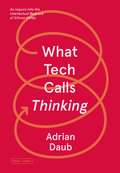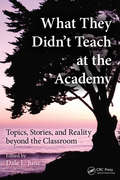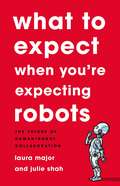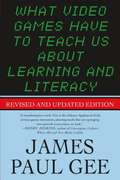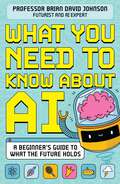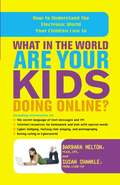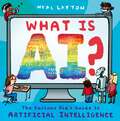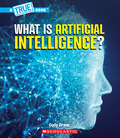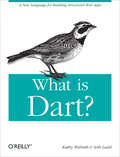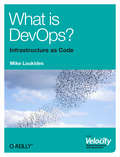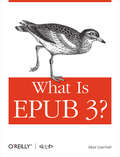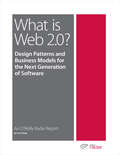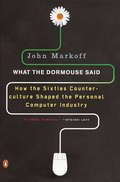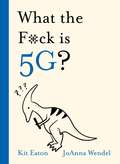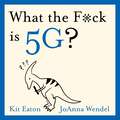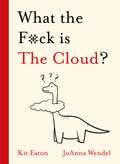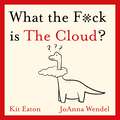- Table View
- List View
What Tech Calls Thinking: An Inquiry into the Intellectual Bedrock of Silicon Valley (FSG Originals x Logic)
by Adrian Daub"In Daub’s hands the founding concepts of Silicon Valley don’t make money; they fall apart." --The New York Times Book Review From FSGO x Logic: a Stanford professor's spirited dismantling of Silicon Valley's intellectual originsAdrian Daub’s What Tech Calls Thinking is a lively dismantling of the ideas that form the intellectual bedrock of Silicon Valley. Equally important to Silicon Valley’s world-altering innovation are the language and ideas it uses to explain and justify itself. And often, those fancy new ideas are simply old motifs playing dress-up in a hoodie. From the myth of dropping out to the war cry of “disruption,” Daub locates the Valley’s supposedly original, radical thinking in the ideas of Heidegger and Ayn Rand, the New Age Esalen Foundation in Big Sur, and American traditions from the tent revival to predestination. Written with verve and imagination, What Tech Calls Thinking is an intellectual refutation of Silicon Valley's ethos, pulling back the curtain on the self-aggrandizing myths the Valley tells about itself.FSG Originals × Logic dissects the way technology functions in everyday lives. The titans of Silicon Valley, for all their utopian imaginings, never really had our best interests at heart: recent threats to democracy, truth, privacy, and safety, as a result of tech’s reckless pursuit of progress, have shown as much. We present an alternate story, one that delights in capturing technology in all its contradictions and innovation, across borders and socioeconomic divisions, from history through the future, beyond platitudes and PR hype, and past doom and gloom. Our collaboration features four brief but provocative forays into the tech industry’s many worlds, and aspires to incite fresh conversations about technology focused on nuanced and accessible explorations of the emerging tools that reorganize and redefine life today.
What They Didn't Teach at the Academy: Topics, Stories, and Reality beyond the Classroom
by Dale L. JuneWhile professional courses and how-to manuals can prepare us for expected events that will occur in the course of our careers, there remains an untapped reservoir of life experience that cannot be prepared for in training or study. Revised to include more information on analytical models for wavelength independence, Radiation Heat Transfer, Augmented Edition has been rearranged, providing problems within each chapter rather than at the end of the book. Written by Ephraim M. Sparrow, a generalist who works on a very broad range of problems that encompasses almost all mechanical engineering topics, the book presents key ideas without being exhaustive. Sparrow is in charge of the Laboratory for Heat Transfer and Fluid Flow Practice, whose function in to undertake both industrially bases and fundamental problems that fall within the bounds of heat transfer and fluid flow.
What To Do When You Get Hacked: A Practitioner's Guide to Incident Response in the 21st Century
by Shimon BrathwaiteWhat To Do When You Get Hacked: A Practitioner’s Guide to Incident Response in the 21st Century teaches you everything that you need to know about preparing your company for a potential data breach. We begin by talking about what the latest cybersecurity threats and attacks are that your company needs to be prepared for. Once we establish that, we go into the different phases of the incident response lifecycle based on the NIST framework. This will teach you how to properly prepare and respond to cybersecurity incidents so that you can be sure to minimize damage and fulfill all of your legal requirements during a cyberattack. This book is meant for the everyday business owner and makes these concepts simple to understand and apply.
What To Expect When You're Expecting Robots: The Future of Human-Robot Collaboration
by Laura Major Julie ShahThe next generation of robots will be truly social, but can we make sure that they play well in the sandbox?Most robots are just tools. They do limited sets of tasks subject to constant human control. But a new type of robot is coming. These machines will operate on their own in busy, unpredictable public spaces. They'll ferry deliveries, manage emergency rooms, even grocery shop. Such systems could be truly collaborative, accomplishing tasks we don't do well without our having to stop and direct them. This makes them social entities, so, as robot designers Laura Major and Julie Shah argue, whether they make our lives better or worse is a matter of whether they know how to behave.What to Expect When You're Expecting Robots offers a vision for how robots can survive in the real world and how they will change our relationship to technology. From teaching them manners, to robot-proofing public spaces, to planning for their mistakes, this book answers every question you didn't know you needed to ask about the robots on the way.
What UX is Really About: Introducing a Mindset for Great Experiences
by Celia Hodent"In this not-too-long and easy-to-read book, author Celia Hodent presents a clear overview of the challenges, demands, and rewards of becoming a user experience professional. If this field interests you, there’s no better place to start than with the volume you now hold in your hand." Alan Cooper, Ancestry Thinker, Software Alchemist, Regenerative Rancher, Author of The Inmates Are Running the Asylum: Why High Tech Products Drive Us Crazy and How to Restore the Sanity The main objective of What UX is Really About: Introducing a Mindset for Great Experiences is to provide a quick introduction to user experience (UX 101) for students, professionals, or simply curious readers who want to understand this trendy yet commonly misunderstood practice better. Readers will learn that UX is much more than a set of techniques, guidelines, and tools. It is a mindset; a philosophy that takes the perspective of the humans that will use a product. It is about solving their problems, offering them a pleasurable experience, and building a win-win, long-lasting relationship between them and the company developing the product. Above all, it is about improving people’s lives with technology. What UX is Really About is informative, concise, and provides readers with a high-level overview of the science, design, and methodologies of UX. KEY FEATURES: • The most approachable and concise introduction book about UX. • Easy to read and aims to popularize the UX mindset while debunking its main misconceptions. • Small format size makes it easy to carry around. • Includes content relatable and meaningful to the readers by taking many examples from everyday life with a conversational and light writing style. • Tackles the psychology, design, research, process, strategy, and ethics behind offering the best experience with products, systems, or services. • Includes a glossary. Celia Hodent holds a PhD in psychology, and is a leading expert in the application of cognitive science and psychology to product development, with over 13 years of experience in the development of UX strategy in video game studios, such as Ubisoft, LucasArts, and Epic Games (Fortnite). She currently leads an independent UX consultancy, working with a wide range of international media and enterprise companies to help ensure their products are engaging, successful, and respectful of users. Celia conducts workshops and provides guidance on the topics of game-based UX, playful learning ("gamification"), ethics, implicit biases, and inclusion in tech. Celia is the author of The Gamer’s Brain: How Neuroscience and UX Can Impact Video Game Design and The Psychology of Video Games.
What Video Games Have to Teach Us about Learning and Literacy
by James Paul GeeJames Paul Gee talks about his experience of learning and using video games. He looks at major specific cognitive activities - to develop a sense of identity, to grasp meanings, to pick a role model and to perceive the world.
What We Talk About When We Talk About Books: The History and Future of Reading
by Leah PriceReports of the death of reading are greatly exaggeratedDo you worry that you've lost patience for anything longer than a tweet? If so, you're not alone. <P><P>Digital-age pundits warn that as our appetite for books dwindles, so too do the virtues in which printed, bound objects once trained us: the willpower to focus on a sustained argument, the curiosity to look beyond the day's news, the willingness to be alone. <P><P>The shelves of the world's great libraries, though, tell a more complicated story. <P><P> Examining the wear and tear on the books that they contain, English professor Leah Price finds scant evidence that a golden age of reading ever existed. From the dawn of mass literacy to the invention of the paperback, most readers already skimmed and multitasked. <P><P>Print-era doctors even forbade the very same silent absorption now recommended as a cure for electronic addictions. The evidence that books are dying proves even scarcer. <P><P>In encounters with librarians, booksellers and activists who are reinventing old ways of reading, Price offers fresh hope to bibliophiles and literature lovers alike.
What Will Be: How the New World of Information Will Change Our Lives
by Michael L. DertouzosMichael Dertouzos has been an insightful commentator and an active participant in the creation of the Information Age.Now, in What Will Be, he offers a thought-provoking and entertaining vision of the world of the next decade -- and of the next century. Dertouzos examines the impact that the following new technologies and challenges will have on our lives as the Information Revolution progresses:all the music, film and text ever produced will be available on-demand in our own homesyour "bodynet" will let you make phone calls, check email and pay bills as you walk down the streetadvances in telecommunication will radically alter the role of face-to-face contact in our livesglobal disparities in infrastructure will widen the gap between rich and poorsurgical mini-robots and online care will change the practice of medicine as we know it. Detailed, accessible and visionary, What Will Be  is essential for Information Age revolutionaries and technological neophytes alike.
What You Need to Know About AI: A beginner’s guide to what the future holds
by Brian David JohnsonThe only book you need on AI - for all curious, fact-gobbling kids age 7+.What actually is AI? Will it take over the world? And one day, will it tidy your bedroom...? In this beginner's guide, learn everything you need to know about AI, from how it helps us discover epic stuff up in space or under the sea, whether it will help you build your very own dinosaur, and why, it won't actually help you write your homework! Written by AI expert and Futurist, Brian David Johnson, you will learn what AI is, where it came from, and how it's already being used in the world of sport, space, medicine, animals and more. You will discover AI's amazing possibilities that might shape the future. And along the way, you'll learn super cool facts, bust some myths, and gain a balanced and informed view on the biggest topic of our time.Designed with fun line illustrations throughout.
What You Need to Know About AI: A beginner’s guide to what the future holds
by Brian David JohnsonThe only book you need on AI - for all curious, fact-gobbling kids.What actually is AI? Will it take over the world? And one day, will it tidy your bedroom . . .? In this beginner's guide, learn everything you need to know about AI, from how it helps us discover epic stuff up in space or under the sea to whether it might help you build your own dinosaur.With AI expert and futurist Brian David Johnson, discover what AI is, where it came from, the incredible ways it's being used today and how it might shape and reimagine your future. Learn that AI is just software and that it won't replace human creativity or imagination, but it could help us do some really cool things. And uncover amazing facts, myth busters and insight from experts around the world!This book offers a balanced, expert and fascinating view on the biggest topic of our time. Designed with fun illustrations throughout.
What a Boy Wants
by Nyrae DawnIf you adore Jennifer E. Smith's The Statistical Probability of Love at First Sight and Jessica Park's Flat-Out Love, you'll love this book.Courtesy of watching his mom's relationships, Sebastian Hawkins knows what girls need to do to get a guy. He has what he considers a PHD in hooking up. When he needs extra cash for a car, Sebastian starts up an online venture as The Hook-up Doctor, to anonymously help girls land the guy of their dreams. Of course, his services don't offer a happily-ever-after guarantee. He's seen firsthand getting together never means staying together. And then he falls in love... With the last girl he would expect...Totally not in his game plan. Suddenly, Sebastian finds himself muddled in the game he's always prided himself on. He can't even pick up girls at parties anymore! Why would anyone want to be in love when it turns you into a stuttering, screwed-up, mess with really lame stalker tendencies? Stalking? Totally not his gig. But the Hook-up Doctor won't let himself go down easily. He's always known how to give a girl what she wants and now it's time to figure out what a boy wants... and he definitely plans on getting it.A companion novel to What a Boy Needs.
What in the World Are Your Kids Doing Online?: How to Understand the Electronic World Your Children Live In
by Barbara Melton Susan ShankleTexting. Blogging. IMing. Technology that has become second nature to our children remains uncharted territory for many parents. What in the World Are Your Kids Doing Online?tells you everything you need to know to navigate the parenting issues technology raises, and arms you with the tools you need to protect your children. This comprehensive, all-purpose guide shows you how to keep up with the latest in computer technology and the Internet—even if you’re a techno-illiterate. You’ll also learn how to: protect your child from cyber-bullies and sexual predators monitor your child’s online activity recognize the danger signs in your child’s use of chat rooms and socializing sites such as MySpace decode the secret language of texting, instant messaging, e-mail, and chat rooms keep your “Cyber-kid” healthy and fit teach your child good on-line study skills help your child build healthy friendships and dating relationships, both on- and off-line gear your rules about the Internet to your child’s age and developmental stage know when to turn the computer offIncludes information on how the cyber world affects children with special needs, learning disorders, and emotional disorders.
What is AI?: The curious kid's guide to artificial intelligence
by Neal LaytonAn easy-to-understand picture book explaining AI to young readers, whilst celebrating how amazing human brains really are!Everyone is talking about artificial intelligence - and we all have LOTS of questions. What exactly is it? Why is it such a big deal? Are there any risks? And how is it going to transform our lives?Award-winning author-illustrator Neal Layton is here to explain all there is to know about AI, from the early computers that could only solve sums to the AI programs of today that can recognise human speech and recommend TV shows - and what AI might be able to do in the future. Along the way, readers will learn just how incredible their human brains really are, and what intelligence is all about.This entertaining non-fiction picture book, illustrated in Neal Layton's trademark zany collage style, is perfect for readers aged 6+ who are always asking HOW something works, and for parents wanting to help their kids make sense of a subject that everyone is talking about.
What is Artificial Intelligence? (A True Book)
by Cody CraneHow is AI changing our lives? Discover the secrets of this cutting-edge technology with this book for young readers.When people think about artificial intelligence (AI), they may picture a futuristic world of flying cars, robots integrated into the human body, and computers ruling the world. However, AI is already a big part of how we live today-from music apps that let us hear our favorite songs to mapping apps that get us where we need to go. What Is Artificial Intelligence? uses engaging, interactive text to introduce readers to this hot topic, and to teach them how it can be used to improve our lives.ABOUT THIS SERIES:The world of media and technology is changing fast-and young students are right there in the thick of it. As children try to make sense of new technologies, they face a variety of critical issues, including how to access reliable sources of information, how to protect themselves online, and how to use technology in mindful and respectful ways. That's where the books in the Our Digital Future series can help. Each title has been developed to help young readers think critically and navigate new technologies with confidence and care.
What is Dart?
by Kathy Walrath Seth LaddThis short, free ebook from March 2012 describes the Dart language, libraries, and tools that help you develop structured, fast, and maintainable web apps that run in any modern browser.
What is DevOps?
by Mike LoukidesHave we entered the age of NoOps infrastructures? Hardly. Old-style system administrators may be disappearing in the face of automation and cloud computing, but operations have become more significant than ever. As this O’Reilly Radar Report explains, we’re moving into a more complex arrangement known as "DevOps."Mike Loukides, O’Reilly’s VP of Content Strategy, provides an incisive look into this new world of operations, where IT specialists are becoming part of the development team. In an environment with thousands of servers, these specialists now write the code that maintains the infrastructure. Even applications that run in the cloud have to be resilient and fault tolerant, need to be monitored, and must adjust to huge swings in load. That was underscored by Amazon’s EBS outage last year.From the discussions at O’Reilly’s Velocity Conference, it’s evident that many operations specialists are quickly adapting to the DevOps reality. But as a whole, the industry has just scratched the surface. This report tells you why.
What is EPUB 3?
by Matt GarrishThis book discusses the exciting new format that is set to unleash a content revolution in the publishing world. Laden with features the printed page could never offer--such as embedded multimedia and scripted interactivity--EPUB 3 will forever change what a book can be. This article walks you through the format and puts it in its place in the digital landscape, explaining why EPUB 3 is set to become the new global standard for ebooks as it also becomes the new accessible standard for ebooks.
What is Web 2.0
by Tim O'ReillyThe concept of "Web 2.0" began with a conference brainstorming session between O'Reilly and MediaLive International. Dale Dougherty, web pioneer and O'Reilly VP, noted that far from having "crashed", the web was more important than ever, with exciting new applications and sites popping up with surprising regularity. What's more, the companies that had survived the collapse seemed to have some things in common. Could it be that the dot-com collapse marked some kind of turning point for the web, such that a call to action such as "Web 2.0" might make sense? We agreed that it did, and so the Web 2.0 Conference was born.In the year and a half since, the term "Web 2.0" has clearly taken hold, with more than 9.5 million citations in Google. But there's still a huge amount of disagreement about just what Web 2.0 means, with some people decrying it as a meaningless marketing buzzword, and others accepting it as the new conventional wisdom.This article is an attempt to clarify just what we mean by Web 2.0.
What the Dormouse Said: How the Sixties Counterculture Shaped the Personal ComputerIndustry
by John MarkoffMost histories of the personal computer industry focus on technology or business. John Markoff's landmark book is about the culture and consciousness behind the first PCs--the culture being counter- and the consciousness expanded, sometimes chemically. It's a brilliant evocation of Stanford, California, in the 1960s and '70s, where a group of visionaries set out to turn computers into a means for freeing minds and information. In these pages one encounters Ken Kesey and the phone hacker Cap'n Crunch, est and LSD, The Whole Earth Catalog and the Homebrew Computer Lab. What the Dormouse Said is a poignant, funny, and inspiring book by one of the smartest technology writers around.
What the F*ck is 5G? (WTF Series)
by Kit EatonWhat the f*ck is 5G, and how does it even work?The world loves 4G phones, tablets and other gizmos and we take the tech for granted...but when that 4 grew up into the next-gen 5, it seems everyone perked up and started caring about phone networking tech. Journalists journaled, politicians, er, politicked, and tin-foil hat wearers reached for the extra-thick reinforced foil. Why all this fuss? Believe it or not, 5G could change the way you live. Because though it seems like smartphones are only good for tiktok and texting, 5G has the power to revolutionise how we interact with public spaces - from concerts and gigs to coffee shops, paving the way for foundational tech like virtual and augmented reality. This book will explain this missing radio link that will propel us into the future of self-driving cars and VR. Oh, and along the way we'll explore why 5G and coronavirus are very definitely and completely, utterly, not the same thing
What the F*ck is 5G? (What the *&%^)
by Kit EatonWhat the f*ck is 5G, and how does it even work?The world loves 4G phones, tablets and other gizmos and we take the tech for granted...but when that 4 grew up into the next-gen 5, it seems everyone perked up and started caring about phone networking tech. Journalists journaled, politicians, er, politicked, and tin-foil hat wearers reached for the extra-thick reinforced foil. Why all this fuss? Believe it or not, 5G could change the way you live. Because though it seems like smartphones are only good for tiktok and texting, 5G has the power to revolutionise how we interact with public spaces - from concerts and gigs to coffee shops, paving the way for foundational tech like virtual and augmented reality. This book will explain this missing radio link that will propel us into the future of self-driving cars and VR. Oh, and along the way we'll explore why 5G and coronavirus are very definitely and completely, utterly, not the same thing
What the F*ck is 5G? (What the *&%^)
by Kit EatonWhat the f*ck is 5G and how does it work?The world loves 4G phones, tablets and other gizmos and we take the tech for granted...but when that 4 grew up into the next-gen 5, it seems everyone perked up and started caring about phone networking tech. Journalists journaled, politicians, er, politicked, and tin-foil hat wearers reached for the extra-thick reinforced foil. Why all this fuss? Believe it or not, 5G could change the way you live. Because though it seems like smartphones are only good for tiktok and texting, 5G has the power to revolutionise how we interact with public spaces - from concerts and gigs to coffee shops, paving the way for foundational tech like virtual and augmented reality. This book will explain this missing radio link that will propel us into the future of self-driving cars and VR. Oh, and along the way we'll explore why 5G and coronavirus are very definitely and completely, utterly, not the same thing.(P) 2021 Hodder & Stoughton Ltd
What the F*ck is The Cloud? (WTF Series)
by Kit EatonWhat the f*ck is the Cloud, and how does it even work?Ah, The Cloud. It's such a useful bit of tech jargon isn't it? The kind that's casually thrown around in work meetings by bosses who (kind of) understand and maybe even at the nerdier type of dinner or drinks parties. People joke about the cloud while others take it for granted and some worry about this mysterious entity where all of our data is stored, accessible at the touch of a screen from anywhere on Earth. But what even is the cloud, and for that matter, where is the cloud?Join us on a journey from the very first iterations of the internet that we know and (sometimes) love, all the way through thorny issues of data collection and storage (weren't we all fooled by the 'ten years on' social media trend, even as we rely on cloud-stored photos of cats to cheer us up?) and discover the mysterious place where The Cloud ominously hovers.
What the F*ck is The Cloud? (WTF Series)
by Kit EatonWhat the f*ck is the Cloud, and how does it even work?Ah, The Cloud. It's such a useful bit of tech jargon isn't it? The kind that's casually thrown around in work meetings by bosses who (kind of) understand and maybe even at the nerdier type of dinner or drinks parties. People joke about the cloud while others take it for granted and some worry about this mysterious entity where all of our data is stored, accessible at the touch of a screen from anywhere on Earth. But what even is the cloud, and for that matter, where is the cloud?Join us on a journey from the very first iterations of the internet that we know and (sometimes) love, all the way through thorny issues of data collection and storage (weren't we all fooled by the 'ten years on' social media trend, even as we rely on cloud-stored photos of cats to cheer us up?) and discover the mysterious place where The Cloud ominously hovers.
What the F*ck is The Cloud? (WTF Series)
by Kit EatonWhat the f*ck is the the Cloud and how does it work?Ah, The Cloud. It's such a useful bit of tech jargon isn't it? The kind that's casually thrown around in work meetings by bosses who (kind of) understand and maybe even at the nerdier type of dinner or drinks parties. People joke about the cloud while others take it for granted and some worry about this mysterious entity where all of our data is stored, accessible at the touch of a screen from anywhere on Earth. But what even is the cloud, and for that matter, where is the cloud?Join us on a journey from the very first iterations of the internet that we know and (sometimes) love, all the way through thorny issues of data collection and storage (weren't we all fooled by the 'ten years on' social media trend, even as we rely on cloud-stored photos of cats to cheer us up?) and discover the mysterious place where The Cloud ominously hovers.(P) 2021 Hodder & Stoughton Ltd
